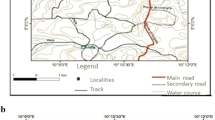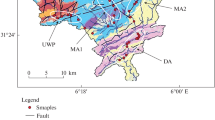Abstract
Mineralogical compositions of five Indian clays have been determined by the petrographic, X-ray, electron-microscopic and differential thermal analysis methods. The relative importance of the methods is discussed and the procedures are described.
Similar content being viewed by others
References
Grim, R. E.Clay Mineralogy, McGraw-Hill Book Co, Inc., New York, 1953.
Klug, H. P. and Alexander, L. E.X-Ray Diffraction Procedures, John Wiley & Sons, Inc., New York, 1954.
Kerr, P. F., Hamilton, P. K. and Pill, R. J.et al. Analytical Data on Reference Clay Minerals, American Petroleum Institute, Project 49, Preliminary Report No. 7, 1950.
Grim, R. E.Clay Mineralogy, McGraw-Hill Book Co., Inc., New York, 1953.
Stourdze, U. Y., Nicot, B. N. F. and Goulart de Andrade, E. “Tubular Morphology of Some Brazilian Kaolinites,”Am. Mineral., 1956,41, 67–75.
Author information
Authors and Affiliations
Additional information
This investigation was made by the author as part of his work on a Colombo Plan Fellowship at the Physical and Crystal Chemistry Section, Mineral Dressing and Process Metallurgy Division, Mines Branch, Department of Mines and Technical Surveys, Ottawa, Canada.
Rights and permissions
About this article
Cite this article
Rao, M.R. Mineralogy of some Indian clays. Proc. Indian Acad. Sci. 43, 359–367 (1956). https://doi.org/10.1007/BF03052745
Received:
Issue Date:
DOI: https://doi.org/10.1007/BF03052745




